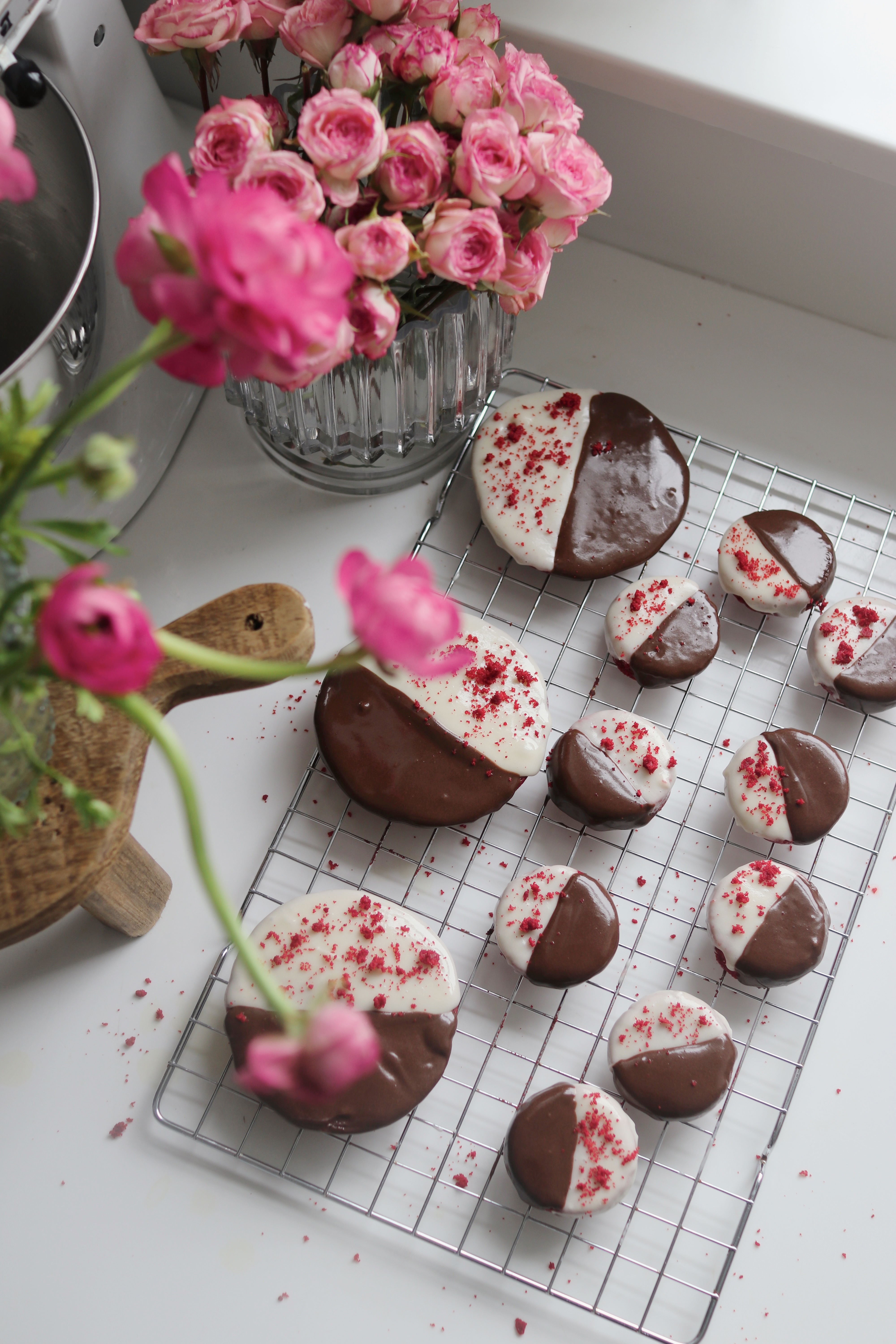I like to think of red velvet as the flavor for those of us who are absolutely loyal chocolate dessert people, but not…triple-fudge-chocolate-dipped-in-more-chocolate dessert people. You know. I want, like, four chips in my chocolate chip cookie, and I want my hot chocolate to taste more like milk than chocolate, and, well, I have to assume that my people are out there, hearing this and nodding.
So, if you are, in fact, my people—you’re gonna love this. As with any traditional red velvet cake, there’s only a small amount of cocoa here (one tablespoon plus one teaspoon, to be exact—plus another few in the icing, but that doesn’t count), a whole bunch of tangy buttermilk and a touch of vinegar. More tang comes in the form of a cream cheese glaze that sits pretty (and flat and shiny and traditional-black-and-white-cookie-looking) on the top of the cookie in much the same way as its more cloyingly sweet predecessor. I simply couldn’t imagine adding anything to the red velvet category without that cream cheese-based icing.
Oh, and about that muffin tin! I love using it to make smaller black-and-white cookies that are perfectly circular—I’ll have to share more about that technique in another post. But for now, you can find the basics below, and I’ve also broken down the recipe so that you can choose your own cookie-size adventure and make sure you’ve got the appropriate, corresponding batter amounts / bake times.



Red Velvet Black-and-White Cookies
Description
The sweetest Valentine’s Day treat—classic black-and-white cookies with an updated red velvet base and tangy cream cheese glaze. One batch yields approximately 24 smaller cookies or about 12 larger cookies.
Ingredients
For the cookies:
- 1 1/4 cups flour
- 1 tablespoon plus 1 teaspoon cocoa powder
- 1/2 teaspoon salt
- 1/2 teaspoon baking soda
- 1/4 teaspoon baking powder
- 6 tablespoons unsalted butter, room temperature
- 3/4 cup sugar
- 1 large egg, room temperature
- 2 teaspoons vanilla
- 3/4 tablespoons red gel food coloring (less is fine; depends on how vivid you’d like the resulting color to be)
- 1 teaspoon white vinegar
- 1/3 cup buttermilk
- i baked in muffin tin 10 min, greased, with 1 tablespoon amounts and big 1/4 cup cookies in pan 13 mins. i let cool 5 min then flipped to continue cooling. for the icing,
For the glaze:
- 2.5 cups confectioners’ sugar, sifted to remove lumps (sift after measuring)
- 8 ounces cream cheese, softened to room temperature
- 3–4 tablespoons water, plus more as needed
- 1 tablespoon light corn syrup, plus more as needed
- 1/2 teaspoon vanilla extract
- 3 tablespoons cocoa powder
Instructions
- Preheat oven to 350 degrees Fahrenheit; for six large black-and-white cookies (traditional size), line two baking sheets with parchment paper; for 24 smaller cookies, grease a 12-cup (~3.5 ounce/cup) muffin tin with cooking spray (I use one with flour, but it’s not necessary).
- Whisk together the dry ingredients (flour, cocoa powder, salt, baking soda, and baking powder) in a medium bowl and set aside. Add the butter to the bowl of a stand mixer fitted with the paddle attachment and cream for 1-2 minutes, then pour in the sugar and continue creaming on high speed until light and fluffy, about 2 more minutes. Scrape down the bowl and beat in the egg, vanilla, food coloring, and vinegar for another minute.
- Turn the machine to low speed and, in three to four batches, alternate adding some of the flour mixture and then some of the buttermilk until it’s all incorporated; don’t over-mix. Scrape down the sides and mix one more time to ensure that all the ingredients are mixed in.
- For large (traditional) cookies: Grease a 1/4-cup measuring cup or cookie scoop and drop one mound of batter about. 3 inches apart onto the prepared baking sheets (remember, they’ll spread quite a bit), only about 4-5 cookies max depending on the size of your pan. I like to run around the edges of each batter mound with an icing spatula or kitchen knife to ensure that the final product looks circular. Bake for about 13 to 14 minutes, then remove from the oven and allow to cool for 5 minutes before transferring to a wire rack and turning over (so that the flat side faces “up”) to continue cooling.
- For smaller cookies: Grease a 1-tablespoon measure and drop one mound of batter into the center of each greased muffin cup. (It’ll look like a very small amount of batter—remember, it’ll “puff up” during the baking process.) Bake for 9 to 11 minutes, then remove from the oven and allow to cool in the pan for at least 3 minutes before transferring the cookies to a wire rack and turning them over (so that the flat side faces “up”) to continue cooling.
- Make the glaze: Add the confectioners’ sugar, cream cheese, water, corn syrup, and vanilla to the bowl of a stand mixer and beat on high speed for about 2 minutes or until smooth. Transfer half of the icing to a medium bowl; to the remainder in the stand mixer, add the cocoa powder, a few teaspoons of water, and another teaspoon of corn syrup (you’re trying to match the consistency of the vanilla glaze. Mix on high speed until incorporated.
- Use an icing spatula or dinner knife to spread the white/vanilla glaze over half of each cookie; once all of the cookie halves are glazed, switch over to the chocolate glaze and ice the other sides. Add red velvet crumbles to the white/vanilla side if desired (I sacrificed one of my smaller cookies to make this happen).
Notes
- It’s crucial that your ingredients are at a true room temperature—try not to take any “shortcuts” to get there. (Melting butter in the microwave is certainly not the same as room temp, for instance!)
- To make the cookies ahead of time, bake the base cookie, let it cool, and store at room temperature in a truly airtight container for up to 2 days before making the glaze and icing them. Note that you can’t make the batter/dough ahead of time here; the ingredients are “activated” as soon as dry meets wet and that’s what yields the cake-like structure of the final cookie. Wrap tightly and freeze frosted cookies for up to two months, then thaw overnight in the fridge and allow to come to room temperature before serving.
